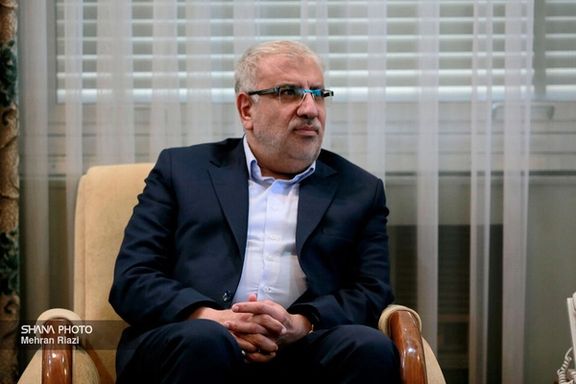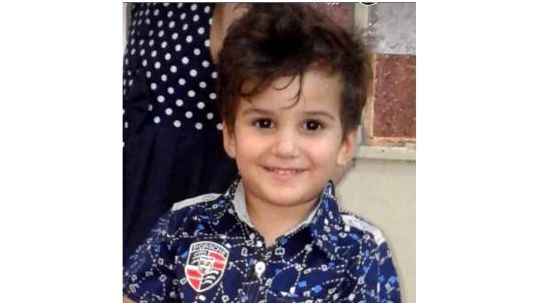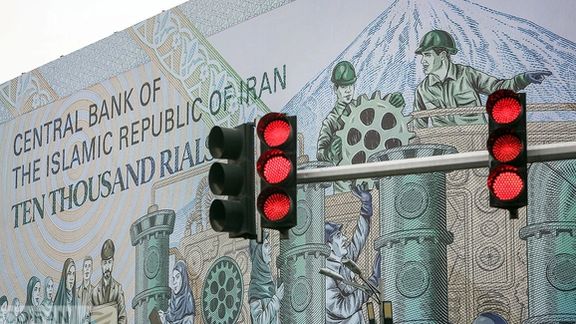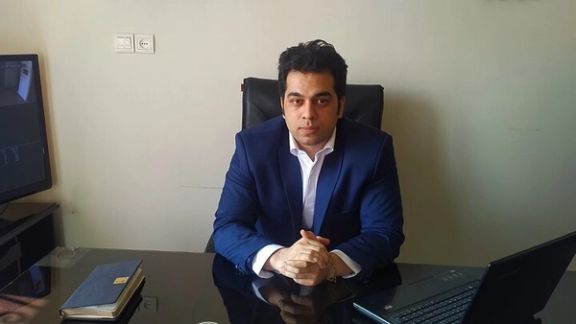Iran’s Oil Minister Claims Nearly $29 Billion In Investments

Iran has invested a total of $28.8 billion in its oil industry in past two years despite financial and technical strains, oil minister Javad Owji said Saturday.

Iran has invested a total of $28.8 billion in its oil industry in past two years despite financial and technical strains, oil minister Javad Owji said Saturday.
Iran’s oil exports are under third-party sanctions by the United States and certain technologies are banned from being sold to Iran. Owji said these factors complicate much-needed investment in the country’s oil and gas industry.
Since assuming office in 2021, Owji has repeatedly said that the energy sector needs close to $250 billion in investments to stay productive and compete with other oil producers in the region. Saudi Arabia has invested hundreds of billion in the past 15 years.
However, various international sanctions have limited Iran’s financial resources, and Western sanctions on technology, some available only from large Western countries have left Iran’s oil and gas sector in an acute need for overhaul.
Lack of investments have led to natural gas shortages, while Iran has the second largest reserves in the world. This in turn reduces production at petrochemical and steel plants as well as deprives electricity generating plants of cleaner energy.
Owji claimed that $14.5 billion was invested in dozens of unfinished and new projects last year, and $14.3 billion is being invested this year.
Although Owji’s claims of large investments cannot be independently verified, and the government has a habit of exaggerating its meager accomplishments, he underlines that the oil industry is the most important economic sector and needs more attention than others.

As attacks on Iran's former Foreign Minister Mohammad Javad Zarif continued following his latest policy statements, some media and politicians have defended him.
Zarif who was the main speaker at a five-hour long audio discussion on the social media app Club House earlier this week, defended his diplomatic approach of negotiations to reduce Western pressure on Iran.
The former foreign minister has long been a target of Iran’s hardliners as the supposed architect of the 2015 JCPOA nuclear deal and allegedly as a man inclined to forge better ties with the West. But in June these attacks intensified as Zarif began to tweet after a long silence.
The Raisi administration-owned daily Iran newspaper wrote Thursday that former Foreign Minister Zarif and former President Hassan Rouhani's foreign policy was nothing more than "begging the West for attention." The daily also charged that their policies were "marked by ignorance, confusion and naivety."
The daily added that Zarif and Rouhani's policies made the Iran's situation and its ties with other countries more complicated than ever. However, the newspaper did not specify its accusations with examples.
The daily wrote that their priority was redefining Iran's relations with the world, but their vision was limited to Europe and the United States. The statement was, of course, mindless of the fact that Iran's 25-year cooperation contract with China was signed under Rouhani with Zarif.

Iran daily also charged that Zarif's foreign policy was limited to furthering the talks over Iran's nuclear program. The daily further charged that Iran's ties with its neighbors were downgraded under President Rouhani.
In fact, it was Iran’s aggressive regional political and military policies and interventions in Syria and Yemen that soured it ties with Sunni Arab states. These policies were part of a grand strategy devised or at least approved by Supreme Leader Ali Khamenei, and not at the presidential level.
While under attack from the conservative camp Zarif said on Thursday that he has no plans whatsoever for the elections and added that he is not the kind of man who would run for the parliament, Zarif said that the controversy over his Clubhouse presence is rooted in the conservative's fear of his possible plans to run for President in 2025. He added that he has no plan to run for the post or to campaign for other politicians.
In the meantime, the editor of Jomhouri Eslami newspaper, Masih Mohajeri suggested that Zarif and his predecessor at the foreign ministry, Ali Akbar Salehi who later played a part in forging the 2015 JCPOA nuclear agreement, should take part in an open debate with the leading hardliners aligned with the current government who have been obstructing the nuclear talks for many years.
Mohajeri wrote that Iranians have a right to know what has happened to the talks and the nuclear program and such a debate can shed light on many ambiguities and show clearly who is right and who is lying about the other sides foreign, economic and domestic policies.
Also defending Zarif on Thursday was the centrist daily Ham Mihan, which attacked the Raisi administration and wrote that the current government portrays a disparaging image of its predecessor and characterizes its performance as "treasonous", while making a lot of fuss about its own meager achievements.
Ham Mihan wrote that the ruling politicians take advantage of the silence of the officials of the previous government and pass unilateral judgements about the Rouhani administration's track record without giving him and his aides a chance to freely respond to the accusations. Ham Miham further lashed out at the Raisi administration for lying about its "achievements" and not tolerating any criticism. The daily claimed that Raisi and his supporters hold more grudges against their political rivals than foreign enemies.
Foreign Policy expert Ghasem Mohebali defended Zarif by saying that what he said showed the difference between two approaches to national interests and the nuclear talks, adding that Zarif's approach was an example of efficiency while the new government's track record has all the signs of inefficiency.
Expediency Council member, moderate conservative politician Mohammad Sadr, on the other hand, defended Zarif and praised his performance regarding the nuclear deal, and attacked Raisi: "I have told Raisi that he is personally responsible for the economic problems resulting from the inconclusive situation of the nuclear talks under his government."

A nine-year-old Iranian boy has been killed after the police opened fire at his father's car in Iran's Khuzestan province on Friday.
Morteza Delf-Zargani’s father says the police started shooting at their car in the city of Shushtar without even a single warning and based on a false report of car theft.
According to the victim’s uncle, “when they saw the police car behind them, they intended to stop, but without any warning the police opened fire and Morteza died on the spot.”
The police claim they received reports about a car theft that fit the description of the family’s vehicle, and the officers ordered the suspect to pull over, but the driver did not pay attention to the warning and sped away.
In March, a two-year-old child was killed after Iranian special forces opened fire at the car carrying him and his family in the central city of Esfahan (Isfahan).
Morteza's case is also reminiscent of Kian Pirfalak, a 10-year-old boy who was killed by the Islamic Republic's security forces when they started shooting at his father's car during the 2022 protests.
Ironically, Morteza's death coincided with Kian's birthday anniversary.
Many innocent bystanders were killed by security forces during months of protests in 2022 and 2023. More than 500 people were shot or killed by security forces using deadly force.
Kian and his family were targeted by plainclothesmen during a night of protests in Izeh. Kian’s father was also paralyzed because of serious injuries he sustained during the attack. The government claimed “terrorists” had fired at the car, but Kian has become a public symbol of the regime’s brutality.

Iran's top Sunni cleric Mowlavi Abdolhamid on Friday slammed the government for spending the country’s money to help other nations and ignoring its own people.
He said the government fails to create jobs which forces many to engage in small criminal activities only to survive, and then hanged when they are caught.
In his sermon the outspoken Mowlavi (title for Sunni cleric) told his congregation in Zahedan, capital of southeastern Sistan-Baluchestan Province, that lack of jobs in his province and some other impoverished areas is the prime reason people are driven to smuggling fuel, minor drug-related offences, or drug trafficking.
In Iran gasoline and especially diesel are extremely cheap (around 10 US cents per gallon) due to heavy government subsidization. This leads to smuggling fuel to neighboring countries such as Pakistan which has long borders with Sistan-Baluchestan.
Many of these individuals, the cleric said, end up in prison or are even executed for committing crimes that involve profiting as little as 5 million rials ($10).

“People have to do all sorts of things just to earn their bread,” he told his congregation who took to the streets after the prayers for the 36th consecutive week to chant anti-government slogans.
Haal Vsh, a website dedicated to human rights and events in Iran’s Baluchestan, reported Friday that security forces cracked down on young Baluchis in various areas of Zahedan after the protests and arrested many.
The Sunni cleric who has proven to be the unofficial voice of the country’s Sunni population has become popular even among Shiites for standing up to the regime and delivering fiery speeches every week since September when the Women, Life, Freedom protests spread across the country.
In his sermon Abdolhamid also brought up the issue of justice for the victims of what has come to be known as the Bloody Friday of Zahedan. On September 30, 2022, security forces opened fire on civilian anti-government protesters killing more than 93 protesters including children and onlookers in Zahedan after Friday prayers.
“Carrying out justice would have brought tranquility and peace [to the locals],” he said. The government has not taken action against those security forces who opened fire on September 30.
“You never remedied our troubles or asked us about what gave us pain,” Abdolhamid said, adding that calm will not be established unless the complaints of workers, teachers, civil servants and pensioners are addressed and remedied.
As Sunni Muslims, Baluch citizens are both an ethnic and religious minority. Estimates of the Iranian Baluch population range from 1.5 to 2 million people. The Baluch community – along with the Kurds -- has always been among the most persecuted minorities and has the largest number of people executed in the country.
Most Baluchis are executed over drug-related charges, but activists say their trials lack due process and poverty-stricken drug mules are often executed without having had proper legal representation.
According to Haal Vsh, the execution of Baluch citizens has increased significantly since last year’s nation-wide protests. It said in a recent report that 182 people were executed in 23 prisons across Iran in the past year of which81% were drug-related.

The US has released damning intelligence showing Tehran and Moscow building a drone manufacturing plant in Russia for use in Ukraine.
On Friday, White House National Security Council spokesperson, John Kirby, said: “This is a full-scale defense partnership that is harmful to Ukraine, to Iran’s neighbors, and to the international community. We are continuing to use all the tools at our disposal to expose and disrupt these activities including by sharing this with the public — and we are prepared to do more.”
Providing further proof for the deepening military relationship between Russia and Iran, The White House released satellite imagery of the planned location of the UAV (unmanned aerial vehicle) manufacturing plant in Russia’s Alabuga Special Economic Zone, about 600 miles (nearly 1,000 kilometers) east of Moscow. The satellite image of the planned location of the purported drone manufacturing plant was taken on April 3.
“We have information that Russia is receiving materials from Iran needed to build a UAV manufacturing plant inside Russia,” said Kirby, who claims the plant could be fully operational early next year.
The intelligence confirmed data by a Wall Street Journal report in February that the two countries had plans to build such a factory, which could make at least 6,000 drones for the war in Ukraine.

Another declassified government graphic shows the drones are built in Iran, shipped across the Caspian Sea to Russia — with a port Iran helped develop — and then transferred to two air bases. “The support is flowing both ways: from Iran to Russia, and from Russia to Iran,” Kirby said.
Kirby added that in response, Russia has offered Iran “unprecedented” defense cooperation, including billions of dollars’ worth of military equipment such as Su-35 fighter jets, attack helicopters, radars and Yak-130 combat trainer aircraft.
According to Kirby, Washington will continue to impose sanctions on the entities involved in the transfer of Iranian military equipment. This is in addition to new steps the Biden administration, along with the European Union and the United Kingdom, has already taken to restrict the transfer of electronic components found in Iranian drones to the battlefield in Ukraine.
Already dozens of individuals and entities involved in sending Iranian Shahed kamikaze drones to Russia have been sanctioned by the United States and Europe. Russia has already used hundreds of these drones to attack military and civilian targets in Ukraine, or to try to overwhelm air defenses during its large-scale missile attacks on cities.
He said the US has released the information in order to the public “to expose and disrupt” the countries’ “full-scale defense partnership.”
A senior administration official -- who asked for anonymity -- told Politico that “Actors like Iran want this kind of behavior to be secret. We are shining a light on it publicly to let Iran know we are aware of exactly what they’re doing, and to build pressure on Iran internationally, having alerted other countries to Iran’s actions."
Kirby added that the administration also plans to announce “a new government advisory to help businesses and other governments better understand the risks posed by Iran’s [unmanned aerial vehicle] program and the illicit practices Iran uses to procure components for it.”
“This will help governments and businesses put in place measures to ensure they are not inadvertently contributing to Iran’s UAV program,” he stated.

Iran’s battered currency has risen by more than 10 percent since early May on hopes of a foreign policy breakthrough, but the economic fundamentals remain bleak.
The rial this week broke through the important psychological barrier of 500,000 against the US dollar, as several media reports spoke of secret contacts with the United States to reach a sort of an interim agreement that would unblock more than $15 billion of Iran’s frozen funds.
The US denied the reports of a deal on Thursday, although it did not reject reports of ongoing contacts. Tehran’s currency market was officially closed on Friday, so the impact of the US announcement, if any, will be felt on Saturday.
Commentators speaking to local media in Tehran said that releasing even $20 billion will not affect the fundamentals of a weak economy and would represent a temporary respite from the pain of oil export sanctions.
Sajjad Burbur, an Iran-based economist, speaking to the reformist Aftab News website Friday warned of the fast-galloping money supply in the country and predicted that eventually the rial can fall further, reaching 700,000 against the US dollar.

Burbur argued that the Islamic Republic has no means of addressing the economic crisis except “therapy talk”, meaning trying to put a good face on the state of affairs and present exaggerated or fake news.
He argued that the government continues to print money to pay its bills, and this will inevitably devalue the currency. “In 2018, the money supply was less than half of all liquidity, but now it is far more than that. All factors that help the dollar rise against the rial have converged together,” he pointed out.
With far less oil export income because of US sanctions, the government continues to print money and makes daily statements to calm the markets.
Promises of close economic cooperation with Russia and China and hints of talks with the United States are designed to boost confidence in the economy, but experts point out that these will not have a lasting impact and economic fundamentals will have the last word.
With annual inflation approaching 70 percent, affording housing and food has become impossible for millions of families.
Housing specially has risen more than ten-fold in the past five years, while salaries have increased at most five-fold.
Owners see their property as a hedge against inflation and adjust prices and rents according to the value of the US dollar, while people’s income is far less.
The average price for one square meter of an apartment in Tehran is around $1,000, roughly the same as in 2018 before the rial bean to fall. People are migrating out of large cities and commuting long distances just to afford rents.

The former chairman of Iran’s central bank, Abdolnasser Hemmati, in a tweet on Friday asked President Ebrahim Raisi why real estate inflation numbers have been withheld by the government in the past five months.
“Do you know anything about how much rents have gone up?” Hemmati asked the president.
Some people hold a full-time job just to pay the rent, while either they or their spouses must work a second job just to afford food. The average worker has a monthly salary of $150, down from $220 last year when the rial was higher at around 300,000 to the dollar.